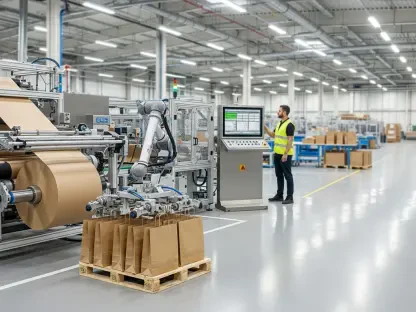The landscape of American manufacturing has been thrust into a challenging spotlight due to recent trade policies that promised protection but seem to deliver pain instead, raising critical questions about their effectiveness. Approximately six months ago, sweeping tariffs were introduced with the intent of shielding domestic industries from foreign competition, yet the reality on the ground tells a different story. Economic indicators and business sentiments alike paint a troubling picture of a sector grappling with declining activity, soaring costs, and pervasive uncertainty. This situation raises critical questions about whether these measures are achieving their goals or inadvertently stifling the very industries they aimed to bolster. As manufacturers navigate this turbulent environment, the broader implications for the economy and consumer prices loom large, demanding a closer examination of the data and feedback from those directly affected.
Economic Fallout from Tariff Policies
Manufacturing Activity in Decline
The impact of the recently imposed tariffs on the manufacturing sector has been starkly negative, as evidenced by consistent economic data. Reports from the Institute for Supply Management (ISM) reveal that the manufacturing index has remained below the critical threshold of 50 for six consecutive months, a clear signal of sector-wide contraction. The most recent figure, recorded at 48.7 for August, shows a marginal uptick from July’s 48, but still underscores a persistent downturn. This prolonged slump suggests that the tariffs, rather than fortifying domestic production, are contributing to a recessionary environment within the industry. Manufacturers face not only reduced output but also heightened uncertainty, which stifles investment and planning for future growth. The numbers reflect a reality where the anticipated benefits of protectionism are overshadowed by immediate economic challenges, leaving many in the sector searching for stability.
Beyond the raw data, the human element of this decline cannot be ignored, as frustration among industry leaders mounts. Anonymous feedback gathered through the ISM survey highlights deep discontent with the current trade policies, with some executives describing the situation as more severe than the Great Recession. This sentiment points to a profound disconnect between policy intent and actual outcomes, where tariffs are seen as a direct cause of operational difficulties. The uncertainty surrounding these measures has led to hesitancy in decision-making, with companies unable to predict costs or market conditions effectively. This paralysis affects not just large corporations but also small and medium-sized enterprises that form the backbone of American manufacturing. As these businesses struggle to adapt, the broader economic ripple effects become increasingly apparent, threatening jobs and community livelihoods across the country.
Business Sentiment Turns Sour
Surveys from other reputable sources further corroborate the negative impact of tariffs on business confidence. A comprehensive study by the Dallas Federal Reserve, involving 329 businesses, found that a mere 2.1% of respondents experienced any positive effects from the tariffs, while a staggering 47.7% reported detrimental consequences. The manufacturing sector bore the brunt of this fallout, with over 70% of firms citing adverse impacts, alongside significant challenges in retail at about 60%. Key issues include escalated input costs, which force companies to raise selling prices, and delayed supplier deliveries that disrupt production schedules. This widespread discontent reveals a policy misstep that undermines competitiveness rather than enhancing it, leaving businesses to grapple with shrinking margins and frustrated customers.
The ripple effects of these challenges are not confined to balance sheets but extend to consumers who ultimately bear the cost. Nearly half of the surveyed businesses, 48.2%, have already passed on the increased expenses to their customers, while an additional 31.9% plan to do so in the near future. This trend suggests an inflationary pressure that could dampen consumer spending and slow broader economic recovery. Optimism for improvement remains scarce, with only 1.6% of respondents anticipating positive outcomes from the tariffs for the remainder of the year. Such pervasive pessimism indicates a critical need for policy reassessment to prevent further erosion of trust in domestic trade strategies. As businesses brace for continued uncertainty, the long-term implications for market stability and economic growth remain a pressing concern that demands attention from policymakers.
Policy Intent Versus Real-World Impact
Disconnect Between Goals and Outcomes
A significant gap exists between the stated objectives of the tariff policies and the realities faced by American manufacturers. The administration introduced these measures with the goal of protecting domestic industries from foreign competition, arguing that such actions would spur growth and job creation. However, the evidence suggests that instead of fostering a robust industrial base, the tariffs have burdened manufacturers with higher costs and operational inefficiencies. This misalignment has led to a situation where the very sector meant to benefit is experiencing a marked decline, as shown by both economic indicators and direct feedback from industry stakeholders. The persistence of these policies despite mounting evidence of harm raises questions about the adaptability of current trade strategies to real-world economic dynamics.
Moreover, the administration’s unwavering commitment to these tariffs, even in the face of potential legal challenges, adds another layer of complexity to the issue. Statements from key figures, such as Treasury Secretary Scott Bessent, indicate a determination to pursue alternative mechanisms to enforce these trade measures, regardless of judicial pushback. This stance risks prolonging the economic strain on manufacturers who are already struggling to maintain competitiveness. The possibility of court intervention offers a glimmer of hope for relief, yet the resolve to continue down this path dims expectations for swift policy change. As the sector navigates these turbulent waters, the disconnect between protective intent and punitive outcome remains a central barrier to recovery and growth.
Path Forward for Manufacturing Relief
Reflecting on the past six months, it became evident that the manufacturing sector endured significant setbacks due to the tariff policies implemented earlier this year. The consistent decline in activity, coupled with overwhelmingly negative business feedback, painted a grim picture of an industry in distress. Higher costs, delayed deliveries, and passed-on price increases to consumers highlighted the unintended consequences of measures meant to protect domestic interests. This period underscored a critical mismatch between policy design and economic reality, leaving lasting impacts on the sector’s stability and confidence.
Looking ahead, actionable steps emerged as vital to mitigating the damage inflicted. Policymakers were urged to consider immediate relief mechanisms, such as temporary tariff suspensions or targeted exemptions for severely affected industries. Engaging with industry leaders to reassess trade strategies could foster policies more aligned with current economic needs. Additionally, exploring judicial avenues to challenge the tariffs offered a potential pathway to alleviate the burden. As the manufacturing sector stood at a crossroads, these considerations promised to guide efforts toward recovery and ensure that future trade policies supported rather than stifled American industry.









